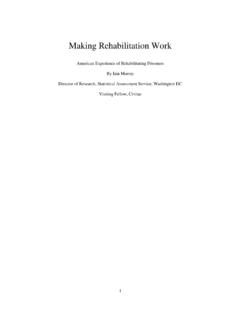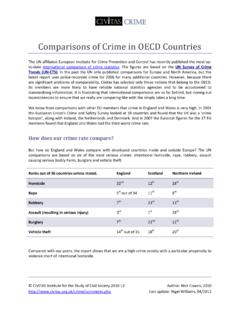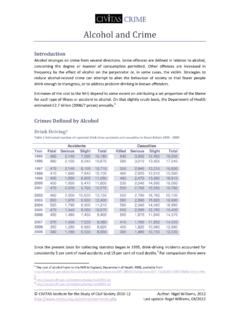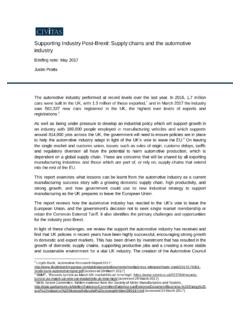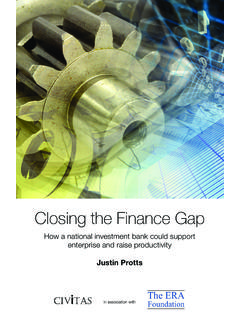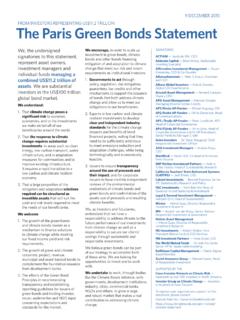Transcription of The Industrial and Commercial Finance Corporation: Lessons ...
1 The Industrial and Commercial Finance Corporation: Lessons from the past for the future David Merlin-Jones Foreword by David G. Green October 2010 Civitas 2010 55 Tufton Street London SW1P 3QL Civitas is a registered charity (no. 1085494) and a company limited by guarantee, registered in England and Wales (no. 04023541) email: Independence: Civitas: Institute for the Study of Civil Society is a registered educational charity (No. 1085494) and a company limited by guarantee (No. 04023541). Civitas is financed from a variety of private sources to avoid over-reliance on any single or small group of donors.
2 All publications are independently refereed. All the Institute s public-ations seek to further its objective of promoting the advancement of learning. The views expressed are those of the authors, not of the Institute. October 2010 3 Foreword Recently there have been calls for the establishment of a new industry bank and the Government has declared its intention of founding a Green Investment Bank. This publication examines the Lessons we can learn from the two industry banks that were set up in 1945. In 1945 the Industrial and Commercial Finance Corporation (ICFC) was founded to provide Finance for small and medium sized firms and in the same year the Finance Corporation for Industry (FCI) was established to focus on large companies.
3 They were merged in 1973 to form Finance for Industry (FFI), which was rebranded Investors in Industry in 1983,and later privatised as 3i in 1994. By the 1980s the character of FFI had altered for the worse but for some 30 years after World War Two the ICFC and its successor provided an invaluable service that has been missing ever since. By the 1930s it was recognised that, whilst the City provided invaluable services for commerce, it was very difficult for small and medium-sized enterprises (SMEs) to raise funds for manufacturing. In 1930 the Bankers Industrial Development Company had been established by the Bank of England to fund Britain s basic industries such as iron and steel, but the Macmillan Committee of 1931 recognised that separate provision was needed for SMEs.
4 The committee, whose members included Keynes and Ernest Bevin, discovered that it was very difficult to raise Finance in the range from 5,000 to 200,000. The problem became known as the Macmillan gap and the same problem was being called the equity gap in 2010, although the range was from 250,000 to one million pounds. David Merlin-Jones study suggests that there are five main Lessons from the experience of the ICFC. First, it established local branches and recruited staff who acquired expertise in specific Industrial sectors and made themselves knowledgeable about individual companies. This allowed them to make shrewd investments, unlike the leading banks of today.
5 As the British Chambers of Commerce (BCC) has found, the big financial institutions often make sweeping judgements about whole sectors and ignore the merits of individual companies, presumably because they are not prepared to take the trouble of understanding the characteristics of particular firms. In its report on export Finance the BCC showed how two companies, one in the materials handling and the other in the automotive parts sector, had been denied export credit insurance because the two sectors were regarded as high risk. The long and successful track record of the two companies affected carried no Second, the ICFC invested for the long term.
6 It understood that market conditions fluctuate and competitive pressures ebb and flow, sometimes leading to corporate collapse. ICFC backed companies with sound business fundamentals regardless of short-run fluctuations. It proved to be a successful business model that paid off for the ICFC as well as its clients. 1 British Chambers of Commerce, Exporting Britain: Trade Finance , 2010, pp. 24 and 26. 4 Third, it would be unwise to establish a new industry bank as a limited company owned by ordinary shareholders who are free to come and go for reasons of their own. What is needed is a bank prepared to back deserving companies over the long term.
7 If funds are to be raised from private investors they should be in the form of bonds or other instruments that insulate the bank from short-term pressures. Fourth, the ICFC was originally established by the Bank of England and relied heavily on the existing banks. The big five used this dependency to undermine the competitive threat that it posed, and it was only when the ICFC was free to compete head on with the main banks that it was able to meet the demand from SMEs. An industry bank today should be established as a rival for the main banks, not as a dependent offshoot. Fifth, there are implications for the proposed Green Investment Bank.
8 The ICFC was successful because it set up local branches and got to know local businesses so that it could judge which were promising and which were not. It did not artificially limit support to narrow sectors but focused on selecting well-run firms with good management teams. There is a grave danger that the Green Investment Bank will pile money into the currently trendy low carbon sector at the expense of many economically sound businesses whose products are not currently glamorous but nonetheless are widely demanded by customers. The folly of expecting governments to pick winners has become a commonplace, and it is true that political pressure heightens the risk that governments will invest in politically well-connected bad bets.
9 It is also true that to some extent governments can not avoid picking winners, and fine judgements must sometimes be made. But the Green Investment Bank is a classic example of selecting a sector on political rather than Commercial grounds. A general industry bank prepared to search high and low for any promising businesses in any sector and any locality would be far more use for our economic survival. David G. Green 5 Introduction The Industrial and Commercial Finance Corporation (ICFC) was created in 1945 as part of a political decision to increase the availability of funding to small and medium sized enterprises (SMEs).
10 Its creation was a reaction to the findings of the Macmillan Committee s report of 1931 which realised: there no recognised and readily accessible channel, corresponding to the new issue market for larger firms, through which the small industrialist can raise long term funds .2 The problem became known as the Macmillan gap . The City and the Stock Exchange were focused on overseas commerce and the big five banks that dominated British banking did not find raising long-term capital for SMEs sufficiently lucrative. The cost to them of providing a loan or making an equity investment of 100,000 was roughly the same as for a much larger sum.

